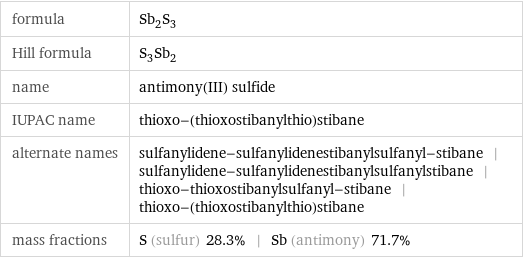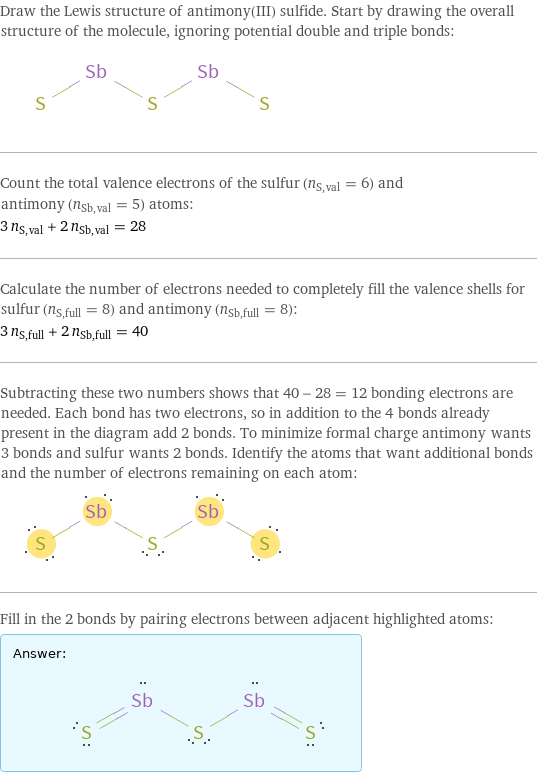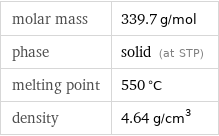Input interpretation

antimony(III) sulfide
Chemical names and formulas

formula | Sb_2S_3 Hill formula | S_3Sb_2 name | antimony(III) sulfide IUPAC name | thioxo-(thioxostibanylthio)stibane alternate names | sulfanylidene-sulfanylidenestibanylsulfanyl-stibane | sulfanylidene-sulfanylidenestibanylsulfanylstibane | thioxo-thioxostibanylsulfanyl-stibane | thioxo-(thioxostibanylthio)stibane mass fractions | S (sulfur) 28.3% | Sb (antimony) 71.7%
Lewis structure

Draw the Lewis structure of antimony(III) sulfide. Start by drawing the overall structure of the molecule, ignoring potential double and triple bonds: Count the total valence electrons of the sulfur (n_S, val = 6) and antimony (n_Sb, val = 5) atoms: 3 n_S, val + 2 n_Sb, val = 28 Calculate the number of electrons needed to completely fill the valence shells for sulfur (n_S, full = 8) and antimony (n_Sb, full = 8): 3 n_S, full + 2 n_Sb, full = 40 Subtracting these two numbers shows that 40 - 28 = 12 bonding electrons are needed. Each bond has two electrons, so in addition to the 4 bonds already present in the diagram add 2 bonds. To minimize formal charge antimony wants 3 bonds and sulfur wants 2 bonds. Identify the atoms that want additional bonds and the number of electrons remaining on each atom: Fill in the 2 bonds by pairing electrons between adjacent highlighted atoms: Answer: | |
Basic properties

molar mass | 339.7 g/mol phase | solid (at STP) melting point | 550 °C density | 4.64 g/cm^3
Units

Solid properties (at STP)

density | 4.64 g/cm^3
Units

Thermodynamic properties

molar heat of fusion | 47.9 kJ/mol specific heat of fusion | 0.141 kJ/g (at STP)
Chemical identifiers
![CAS number | 1345-04-6 PubChem CID number | 16685273 PubChem SID number | 24853278 SMILES identifier | S=[Sb]S[Sb]=S InChI identifier | InChI=1/3S.2Sb/rS3Sb2/c1-4-3-5-2 RTECS number | CC9450000 MDL number | MFCD00011217](../image_source/4f6e07efe1d9e17603bead5135b6b975.png)
CAS number | 1345-04-6 PubChem CID number | 16685273 PubChem SID number | 24853278 SMILES identifier | S=[Sb]S[Sb]=S InChI identifier | InChI=1/3S.2Sb/rS3Sb2/c1-4-3-5-2 RTECS number | CC9450000 MDL number | MFCD00011217